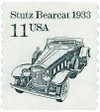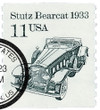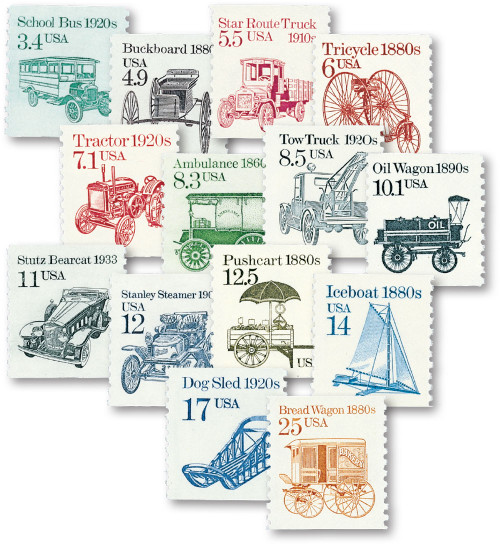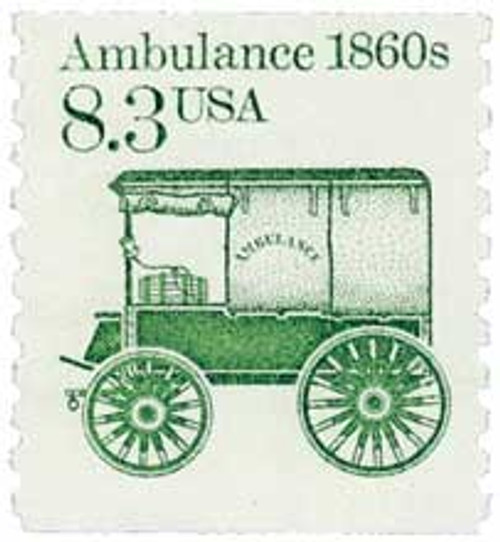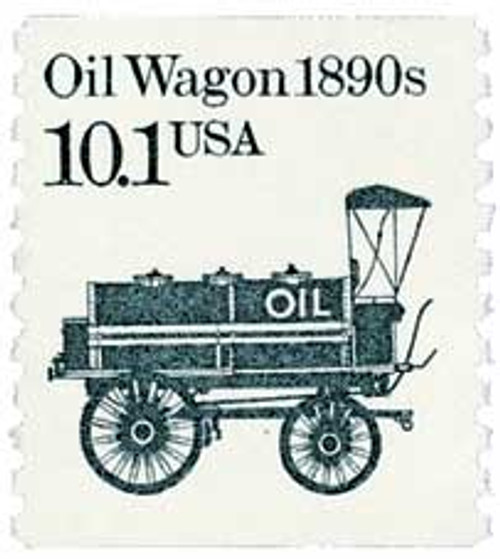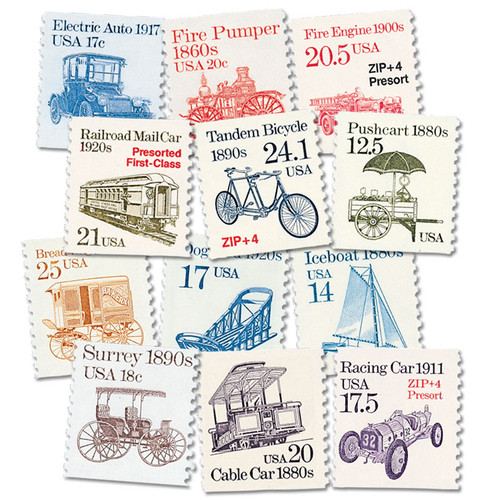
# 2131 - 1985 11c Transportation Series: Stutz Bearcat, 1933
U.S. #2131
1985 11¢ Stutz Bearcat, 1933
Transportation Series
- First stamp issued specifically for the first-class presorted postcard rate
- The Bearcat was the first automobile labeled a “sports car”
- Fastest car in America at the time
Stamp Category: Definitive
Series: Transportation
Value: 11¢; the rate for first-class presorted post cards
First Day of Issue: June 11, 1985
First Day City: Baton Rouge, Louisiana
Quantity Issued: 58,420,000
Printed by: Bureau of Engraving and Printing
Printing Method: Engraved
Format: Coils of 500 and 3,000
Perforations: 10 Vertical
Color: Dark green
Why the stamp was issued: This stamp paid the first-class rate for postcards presorted to at least 10 postcards per carrier route.
About the stamp design: Artist Ken Dallison created a pen and ink drawing for this stamp based on images of an antique Bearcat.
First Day City: This stamp’s First Day ceremony was held at the Cars of Yesteryears Museum in Baton Rouge, Louisiana. Collectors were disappointed, suggesting the stamp should have been issued in Indianapolis, where Harry Stutz developed his first Bearcat.
About the Transportation Series: On May 18, 1981, the USPS issued the first stamp in the Transportation Series, US #1907, picturing the Surrey, a doorless four-wheeled carriage. For the first time in US history, a coil stamp featured its own unique design rather than simply copying that of the current definitive stamp. Over 50 more coil stamps would be issued over the course of the next 15 years, each picturing a different mode of transportation. All of these types of transportation were used since American independence.
The various denominations provided face values to exactly match the rates for several categories of Third-Class mail (bulk rate and quantity-discounted mail). As the rates changed, new stamps with new values were added. Never before had a stamp series included so many fractional cent values.
The Bureau of Engraving and Printing printed most of the stamps in the Transportation Series, although private contractors printed a few. All but a few of the later stamps were produced by engraved intaglio. Differences in precancels, tagging, paper and gum provide a large number of varieties.
Scott Catalog separates the Transportation stamps into four groups. The stamps in the first group (#1897-1908) generally have the denomination in small type with a “c” next to it. These stamps were printed on the Cottrell rotary press, which joined together two plates to make a sleeve. The gaps between these plates created depressions where ink would collect and create joint lines on the stamps. Later issues were printed on a different press and didn’t have these joint lines.
The second group (#2123-36) had larger numbers with no “c.” The third group (#2252-66) was similar in appearance to the second group, but service inscriptions were added to the designs. These stamps also used a variety of paper and gum as well as different types of tagging. The fourth group (#2451-68) marked the end of fractional values. Now bulk mailers would use either the 5¢ or 10¢ stamp and then pay the difference from the actual postage rate.
The last stamp in the Transportation Series, the 20¢ Cog Railway, was issued on June 9, 1995, at the TEXPEX ’95 stamp show in Dallas, Texas. This marked the end of the largest US definitive series up to that time. Three new series would eventually replace it – American Transportation, American Culture, and American Scenes. Additionally, the Great Americans would go on to become the largest American definitive series.
History the stamp represents: Designed by Harry Stutz, the Stutz Bearcat was the fastest car in America at the time, and also the first to be labeled a “sports car.” The Bearcat was a status symbol for wealthy young people in the early 20th century. In 1914, it cost $2,000 when a Ford Model T was priced at $500. It was a sports car that proved itself on the racetrack and in endurance races.
The Bearcat was offered to the public in 1912, after placing 11th at the Indianapolis 500 the year before. Bearcats went on to win 25 of the 30 races they were entered in. In 1915, Erwin “Cannon Ball” Baker drove from California to New York in his Bearcat. It took him eleven days, seven hours, and fifteen minutes, a new record.
The sports car was a shorter, lighter model than Stutz’s passenger car. It had bucket seats, no roof, and a small, round “monocle” windshield for the driver. The production cars were like the race cars except they had fenders, lights, and a trunk.
U.S. #2131
1985 11¢ Stutz Bearcat, 1933
Transportation Series
- First stamp issued specifically for the first-class presorted postcard rate
- The Bearcat was the first automobile labeled a “sports car”
- Fastest car in America at the time
Stamp Category: Definitive
Series: Transportation
Value: 11¢; the rate for first-class presorted post cards
First Day of Issue: June 11, 1985
First Day City: Baton Rouge, Louisiana
Quantity Issued: 58,420,000
Printed by: Bureau of Engraving and Printing
Printing Method: Engraved
Format: Coils of 500 and 3,000
Perforations: 10 Vertical
Color: Dark green
Why the stamp was issued: This stamp paid the first-class rate for postcards presorted to at least 10 postcards per carrier route.
About the stamp design: Artist Ken Dallison created a pen and ink drawing for this stamp based on images of an antique Bearcat.
First Day City: This stamp’s First Day ceremony was held at the Cars of Yesteryears Museum in Baton Rouge, Louisiana. Collectors were disappointed, suggesting the stamp should have been issued in Indianapolis, where Harry Stutz developed his first Bearcat.
About the Transportation Series: On May 18, 1981, the USPS issued the first stamp in the Transportation Series, US #1907, picturing the Surrey, a doorless four-wheeled carriage. For the first time in US history, a coil stamp featured its own unique design rather than simply copying that of the current definitive stamp. Over 50 more coil stamps would be issued over the course of the next 15 years, each picturing a different mode of transportation. All of these types of transportation were used since American independence.
The various denominations provided face values to exactly match the rates for several categories of Third-Class mail (bulk rate and quantity-discounted mail). As the rates changed, new stamps with new values were added. Never before had a stamp series included so many fractional cent values.
The Bureau of Engraving and Printing printed most of the stamps in the Transportation Series, although private contractors printed a few. All but a few of the later stamps were produced by engraved intaglio. Differences in precancels, tagging, paper and gum provide a large number of varieties.
Scott Catalog separates the Transportation stamps into four groups. The stamps in the first group (#1897-1908) generally have the denomination in small type with a “c” next to it. These stamps were printed on the Cottrell rotary press, which joined together two plates to make a sleeve. The gaps between these plates created depressions where ink would collect and create joint lines on the stamps. Later issues were printed on a different press and didn’t have these joint lines.
The second group (#2123-36) had larger numbers with no “c.” The third group (#2252-66) was similar in appearance to the second group, but service inscriptions were added to the designs. These stamps also used a variety of paper and gum as well as different types of tagging. The fourth group (#2451-68) marked the end of fractional values. Now bulk mailers would use either the 5¢ or 10¢ stamp and then pay the difference from the actual postage rate.
The last stamp in the Transportation Series, the 20¢ Cog Railway, was issued on June 9, 1995, at the TEXPEX ’95 stamp show in Dallas, Texas. This marked the end of the largest US definitive series up to that time. Three new series would eventually replace it – American Transportation, American Culture, and American Scenes. Additionally, the Great Americans would go on to become the largest American definitive series.
History the stamp represents: Designed by Harry Stutz, the Stutz Bearcat was the fastest car in America at the time, and also the first to be labeled a “sports car.” The Bearcat was a status symbol for wealthy young people in the early 20th century. In 1914, it cost $2,000 when a Ford Model T was priced at $500. It was a sports car that proved itself on the racetrack and in endurance races.
The Bearcat was offered to the public in 1912, after placing 11th at the Indianapolis 500 the year before. Bearcats went on to win 25 of the 30 races they were entered in. In 1915, Erwin “Cannon Ball” Baker drove from California to New York in his Bearcat. It took him eleven days, seven hours, and fifteen minutes, a new record.
The sports car was a shorter, lighter model than Stutz’s passenger car. It had bucket seats, no roof, and a small, round “monocle” windshield for the driver. The production cars were like the race cars except they had fenders, lights, and a trunk.






